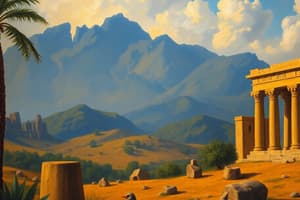Podcast
Questions and Answers
Which civilization is known for its advanced urban planning and drainage systems?
Which civilization is known for its advanced urban planning and drainage systems?
- Ancient Greece
- Mesoamerican Civilizations
- Ancient Rome
- Indus Valley Civilization (correct)
What significant legal document was created in Mesopotamia?
What significant legal document was created in Mesopotamia?
- The Magna Carta
- The Code of Hammurabi (correct)
- The Twelve Tables
- The Edicts of Ashoka
Which ancient civilization is credited with the invention of papermaking?
Which ancient civilization is credited with the invention of papermaking?
- Ancient Greece
- Ancient China (correct)
- Ancient Rome
- Mesoamerican Civilizations
What system of writing did the Egyptians use?
What system of writing did the Egyptians use?
Which of the following is NOT a notable contribution of Ancient Greece?
Which of the following is NOT a notable contribution of Ancient Greece?
Which civilization is famous for its pyramids and mummification practices?
Which civilization is famous for its pyramids and mummification practices?
Which ancient civilization developed the Great Wall?
Which ancient civilization developed the Great Wall?
Which of the following ancient cultures used a form of writing called hieroglyphics?
Which of the following ancient cultures used a form of writing called hieroglyphics?
Flashcards are hidden until you start studying
Study Notes
Ancient Civilizations
Mesopotamia
- Location: Between the Tigris and Euphrates rivers (modern-day Iraq).
- Key Features:
- Birthplace of writing (cuneiform).
- Development of city-states like Ur and Babylon.
- Innovations in irrigation, mathematics, and astronomy.
- Notable Contributions: The Code of Hammurabi, early legal systems.
Ancient Egypt
- Location: Nile River Valley (modern Egypt).
- Key Features:
- Famous for pyramids and pharaohs.
- Hieroglyphics as a writing system.
- Advanced medicine and mummification practices.
- Notable Contributions: Calendar, mathematical concepts, and monumental architecture.
Indus Valley Civilization
- Location: Northwestern regions of South Asia (modern Pakistan and northwest India).
- Key Features:
- Urban planning with sophisticated drainage systems.
- Major cities: Harappa and Mohenjo-Daro.
- Use of standardized weights and measures.
- Notable Contributions: Early urban sanitation and trade networks.
Ancient China
- Location: East Asia, primarily along the Yellow River.
- Key Features:
- Dynastic rule; notable dynasties include Shang and Zhou.
- Development of Confucianism and Daoism as philosophies.
- Inventions like papermaking and the compass.
- Notable Contributions: The Great Wall and the Silk Road trade routes.
Mesoamerican Civilizations
- Key Cultures: Maya, Aztec, and Olmec.
- Key Features:
- Complex calendars and astronomical systems.
- Advanced agricultural methods (e.g., terrace farming).
- Use of hieroglyphics and other writing systems (Maya).
- Notable Contributions: Architectural achievements like pyramids and temples.
Ancient Greece
- Location: Southeastern Europe, including city-states like Athens and Sparta.
- Key Features:
- Birthplace of democracy and philosophy.
- Contributions to art, drama, and literature (Homer, Plato).
- Olympic Games originated here.
- Notable Contributions: Political systems, scientific inquiry, and theater.
Ancient Rome
- Location: Centered around the Mediterranean, primarily Italy.
- Key Features:
- Republic transitioning to empire under Augustus.
- Development of laws and infrastructure (roads, aqueducts).
- Influence of Greek culture and language.
- Notable Contributions: Codification of laws, engineering techniques, and the spread of Christianity.
Mesopotamia
- Located between the Tigris and Euphrates rivers, in modern-day Iraq.
- Birthplace of cuneiform writing, an early form of writing using wedge-shaped marks.
- Known for its development of city-states like Ur and Babylon.
- Made advancements in irrigation, mathematics, and astronomy.
- The Code of Hammurabi, an early legal system, originated in Mesopotamia.
Ancient Egypt
- Situated in the Nile River Valley of modern Egypt.
- Famous for its pyramids, impressive structures built as tombs for pharaohs, the rulers of Egypt.
- Used hieroglyphics, a picture-based writing system.
- Developed advanced medical practices and mummification techniques.
- Contributed to the development of a calendar, mathematical concepts, and monumental architecture.
Indus Valley Civilization
- Flourished in northwestern regions of South Asia, including modern Pakistan and northwest India.
- Known for its well-planned cities with sophisticated drainage systems.
- Major cities included Harappa and Mohenjo-Daro, which featured elaborate urban planning and infrastructure.
- Used standardized weights and measures for trade and commerce.
- Made advancements in urban sanitation and established extensive trade networks throughout the region.
Ancient China
- Primarily located in East Asia, along the Yellow River.
- Characterized by dynastic rule, with notable dynasties including the Shang and Zhou dynasties.
- Developed Confucianism and Daoism, influential philosophies that shaped Chinese culture and society.
- Invented papermaking and the compass.
- Notable contributions include the Great Wall of China and the Silk Road trade routes.
Mesoamerican Civilizations
- Comprised key cultures such as the Maya, Aztec, and Olmec.
- Developed complex calendars and astronomical systems.
- Utilized advanced agricultural methods, including terrace farming.
- Used hieroglyphics and other writing systems, particularly the Maya civilization.
- Famous for their architectural achievements, including pyramids and temples.
Ancient Greece
- Occupied southeastern Europe, including city-states such as Athens and Sparta.
- Birthplace of democracy, a system of government where citizens have a say in decision-making.
- Known for its contributions to philosophy, with influential figures like Plato.
- Made significant contributions to art, drama, and literature, exemplified by Homer's epic poems.
- The Olympic Games, a series of athletic contests held in honor of the Olympian gods, originated in Greece.
- Played a crucial role in the development of political systems, scientific inquiry, and theater.
Ancient Rome
- Centered around the Mediterranean Sea, with Italy at its heart.
- Transitioned from a republic to an empire under the rule of Augustus.
- Developed a sophisticated legal system and impressive infrastructure, including roads and aqueducts.
- Significantly influenced by Greek culture and language.
- Notable for its codification of laws, advancements in engineering techniques, and the spread of Christianity.
Studying That Suits You
Use AI to generate personalized quizzes and flashcards to suit your learning preferences.




